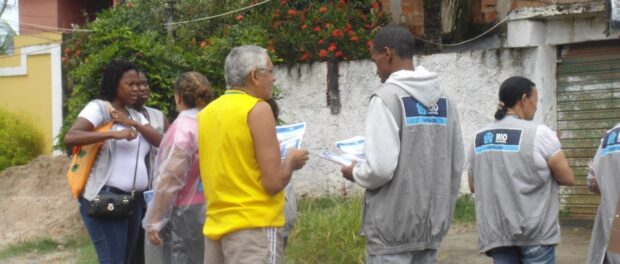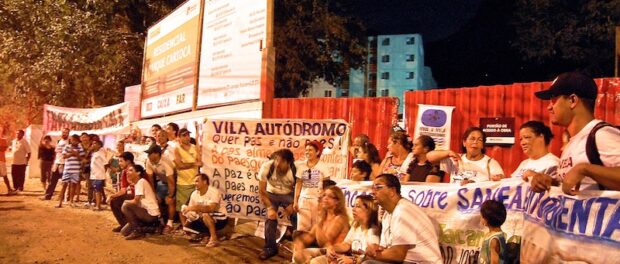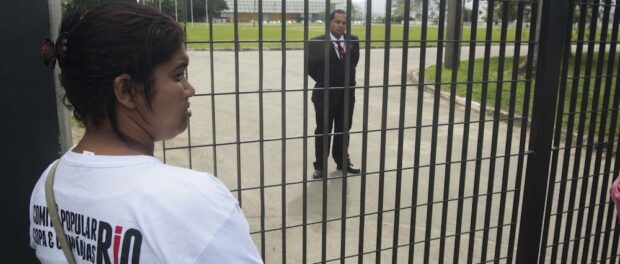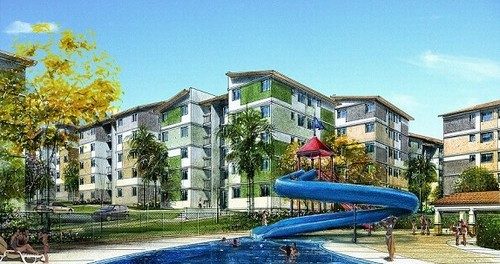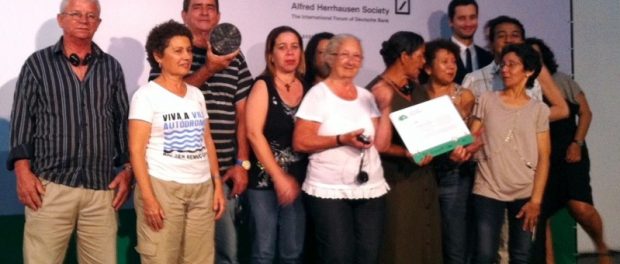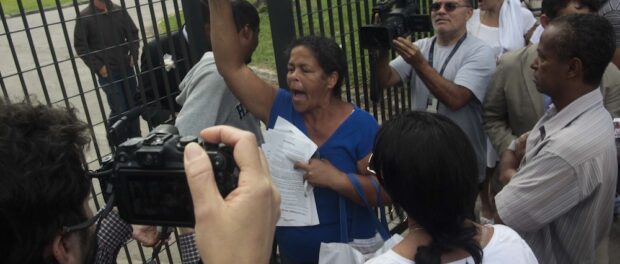
This is the fourth article in a six-part series that comprises the book chapter entitled “Not Everyone Has a Price: How the Small Favela of Vila Autódromo’s Fight Opened a Path to Olympic Resistance” recounting the story of Vila Autódromo’s struggle. Written by Theresa Williamson, executive director of Catalytic Communities,* the chapter is part of the book ‘Rio 2016: Olympic Myths, Hard Realities‘ edited by economist Andrew Zimbalist. To read our review of ‘Rio 2016,’ click here. RioOnWatch would like to thank Brookings Press for providing the permission to republish the chapter here in its entirety.
By the end of 2012 all of the ingredients were thus in place for what would unfold over the next critical year. Vila Autódromo’s resistance was on a very strong footing and continued expanding in early 2013. The compelling Popular Plan was being distributed, a strong network of community leaders assembled and organized, a diverse range of partners engaged, the global media beginning to pay attention, and the community’s legal battle firmly unresolved. Legally speaking, the mayor would not be able to remove the community without their consent or a justification for the application of eminent domain. And given the community’s visibility and organizing, a violent forced lightening eviction was increasingly out of the question politically.
In April 2013 urban planning professor Lawrence Vale at MIT published the first extensive summary of the Vila Autódromo struggle, comparing it with the Atlanta Olympics, in Places, The Design Observer. Entitled “The Displacement Decathlon: Olympian Struggles for Affordable Housing from Atlanta to Rio de Janeiro,” the article’s publication made clear the international reach and reputation of Vila Autódromo’s resistance. That same month, Vila Autódromo made its compelling case on Australia’s Special Broadcasting Service (SBS) via the short documentary “Reshaping Rio.”
At this point the mayor of a city in an advanced democracy might have stopped and negotiated collectively or recognized the political damage that insisting on the eviction of a small, well-supported community like this would cause and might have changed course. But in Rio, Mayor Eduardo Paes instead buckled down in his approach, obviously committed to the behind-the-scenes demands of the real estate moguls who would ultimately benefit from the eviction and who were responsible for building the Olympic park.
What had started in late 2011 only intensified in the early months of 2013, when the municipal housing secretariat expanded its door-to-door pressure over the community. Municipal workers used a variety of means to fill out forms on which they listed everything from resident names and addresses to how interested they were in relocation and how large their homes were. Some residents testified that they refused to speak to these workers, while others said that relatives provided information without realizing what was at stake or that they responded in fear that they would be left out of an eventual forced resettlement.
The purpose of this extensive and highly questionable surveying process was made clear on July 1, 2013, at OsteRio, an exclusive debate series hosted by the Institute for the Study of Labor and Society (Instituto de Estudos de Trabalho e Sociedade or IETS), a well-respected labor and urban economics think tank in Rio. At the event, to an audience of some sixty executives, journalists, researchers, and NGOs, the mayor announced that 70 percent of Vila Autódromo’s residents wanted to leave. Having had their names added to the survey forms, regardless of their reason for doing so, effectively served as an admission of willingness, or even desire, to relocate, according to the mayor’s claim.
Vila Autódromo residents followed up by organizing a large protest on July 20, 2013. The competing narratives were coming to a head when, in early August, Mayor Eduardo Paes called a meeting with Vila Autódromo’s leaders, municipal secretaries of environment and housing, submayors for Barra da Tijuca and Jacarepaguá, a representative of the Municipal Olympic Corporation, and the city’s attorney general.
At the meeting on August 9, 2013, Vila Autódromo was represented by a number of community leaders and residents, public defenders, the Catholic Church’s favela outreach group, and technical partners from UFRJ and UFF who had helped draw up the Popular Plan. Leaders left the meeting hopeful, declaring themselves victorious, after the mayor had publicly acknowledged mistakes in how the community had been treated and agreed to open a round of collective negotiations to upgrade and “guarantee the community’s permanence,” stating that eventual cases of resettlement would be made only “in the same area, if a resident so desires.”
Over the next month, into September, a working group composed of residents and their university technical aids worked with the city’s environment secretary, housing secretary, and municipal architects over a series of weekly meetings to agree on the upgrading plan. Vila Autódromo’s working group was clear in its commitment to permit no evictions and used the jointly developed Popular Plan as the basis for negotiation. City officials, however, came to these meetings with an entirely different set of plans, requiring significant removals, which they would not relinquish. They refused to speak of other details without agreeing to some removals. As a result, community organizers did not negotiate further. They knew of the city’s common tactic, using scattered removals to initiate larger evictions in other communities. In these cases, the demolition of a handful of homes resulted in a domino effect, with frightened neighbors giving up one by one and entire communities eventually dismantled. From such divergent positions, the meetings were inconsequential, and by mid-September it was clear to community members that the mayor had made his public statements in bad faith, “for the English to see.”[a]
Within two weeks of these negotiations, approximately one hundred Vila Autódromo residents received an invitation from the mayor for a closed-door meeting to be held down the road in Rio’s convention center, RioCentro, on October 6, 2013. These one hundred residents were decidedly not those elected by residents to represent the community in the public negotiations. Nor were they among the hundreds of resisters. It was clear that the SMH workers’ data on those willing to negotiate formed the basis of whom would be invited to the big event. The city had selected only those willing to negotiate, and the mayor would see just them.
The small rift in the community exposed at Bittar’s event in late 2011 thus ultimately proved catastrophic to the community as a whole two years later. Sunday morning, hundreds of Vila Autódromo residents who had not been invited to the meeting were joined by an equal number of journalists and supporters when they stormed Rio-Centro, barging through a fence across a security outpost, traversing a pool, and finally accessing the building, where they were barred entry from the large hall where Paes addressed invited residents for over half an hour. Not only were uninvited community residents and their elected leadership barred entry but the BBC was too, as were all the alternative and freelance journalists in attendance.
Meanwhile, inside the mayor had nearly a full hour’s private audience with those one hundred residents. The only media outlet allowed in during this time was O Globo, and executives of Olympic park construction companies were also in the room. After several Vila Autódromo residents were injured by private security guards in their attempts to enter, unable to accept the idea that such a closed-door meeting would decide their future, the mayor finally approved entry of community residents, one of the university planners assisting them, and a handful of professional journalists. All other supporters and media were forced to remain just outside the double doors.
Inside, those who had received invitations to attend were given priority in taking the microphone, and very few others had an opportunity to speak. During his long presentation highlighting plans for rehousing the community in Parque Carioca, the public housing project advertised with a toboggan waterslide “especially for Vila Autódromo,” Mayor Paes made announcements that broke with his previous statements and with standard protocol regarding public housing rules. He stated, for example, that owners of multiple properties in Vila Autódromo would be compensated with several properties, when public housing is supposed to be issued on the basis of need and not speculation. He also stated that residents would be permitted to sell their new public housing units immediately, when normally there would be a ten-year permanency requirement, and that renters in Vila Autódromo would be given apartments in Parque Carioca, when renters normally would not receive any compensation during eviction. Finally, he declared that more valuable homes could opt for “market rate” compensation. Those residents that asked for upgrading according to the Popular Plan were told by the mayor that they could make their way to the city’s regional office to sign up for relocation or compensation.
By this point it had become clear that the mayor found himself caught between a rock and a hard place. His personal interests and political promises to developers were his sole commitment, yet the legal system was not concluding the case in the city’s favor, and time would eventually run out to meet those commitments. Otherwise, there would be no need to negotiate separately—he could have kept his August promise to relocate only those who wanted it while upgrading the remainder of the community. If his goal was to remove the entire community, something that could be argued to be “consensual relocation” would be his only viable option, so identifying and convincing those families that had not participated in the broader community resistance and which were living in precarious situations to leave first was his most viable strategy.
So beginning with this meeting, and despite Vila Autódromo’s Popular Plan being chosen from among 170 Rio de Janeiro–based projects as winner of the December 3, 2013, prestigious Deutsche Bank Urban Age Award, the city entered a phase of mixing endless and diverse forms of intimidation with negotiations family by family, detecting what would convince each to move instead of upgrading their neighborhood. The administration even went so far as to forge a protest in favor of relocation, hiring two buses to carry twenty residents to city hall where they “protested” to be assigned to public housing. That same night, community organizers were hosting a community meeting with nearly 200 residents signing a commitment to staying.
And so it happened, one by one, families living in more precarious situations, attracted by the glossy ads, were the first to go, taking apartments in Parque Carioca. Once their homes were demolished, fear began settling in among their neighbors, with one wave after another of residents taking various levels of compensation over the course of 2014, with the largest wave following the Evangelical Church’s settlement offer. The community’s Evangelical Church had received a very large offer to relocate, leading its parishioners to follow suit. Offers began at just one apartment, but shortly after families began receiving two or even multiple apartments. Once no one was willing to take an apartment, the city began offering financial compensations, which increased from tens of thousands of reais to their peak at R$3 million ($1 million), delivered to a colonel who owned a property there. These offers, in the context of a community crumbling under bulldozers, dust, cut services, and other forms of duress, led even some who had declared themselves utterly committed to staying to ultimately leave.
Click here for Part 5.
This is the fourth article in a six-part series that comprises the chapter entitled “Not Everyone Has a Price: How the Small Favela of Vila Autódromo’s Fight Opened a Path to Olympic Resistance” recounting the story of Vila Autódromo’s struggle. The chapter is part of the book ‘Rio 2016: Olympic Myths, Hard Realities.’ RioOnWatch would like to thank Brookings Press for providing the permission to republish the chapter here in its entirety.
Notes
[a] An expression arising in the early nineteenth century in Brazil reflecting the cultural tendency to engage in empty public promises—even law-making—that is not truly intended for implementation but rather to buy time, mask over true motives, or otherwise permit unpopular actions to take place, as was done with the Canudos soldiers who were promised land in Rio.
Videos Cited Above in Text:
Complete Series: Not Everyone Has a Price: The Story of Vila Autódromo’s Olympic Struggle
Part 1: (Re)Introducing Favelas
Part 2: Introducing Vila Autódromo
Part 3: Vila Autódromo’s Rise as a Symbol of Olympic Resistance (2010-2012) [VIDEO]
Part 4: Intimidation and the Critical Turning Point (2013-2014) [VIDEO]
Part 5: The City Proceeds with Eminent Domain and Violence (2014-2016) [VIDEO]
Part 6: Conclusion—Vila Autódromo in the Context of Rio’s Olympic Evictions
Also see: Timeline of Vila Autodromo
*RioOnWatch is a project of the NGO Catalytic Communities

